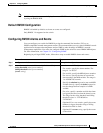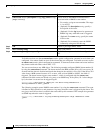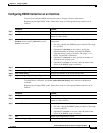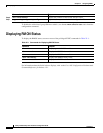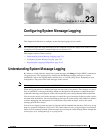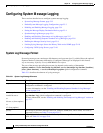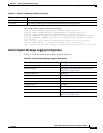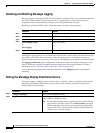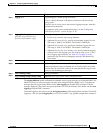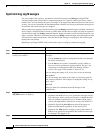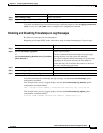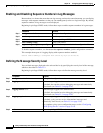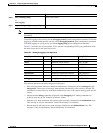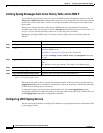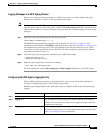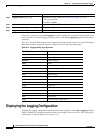
23-5
Catalyst 2950 Desktop Switch Software Configuration Guide
78-14982-01
Chapter 23 Configuring System Message Logging
Configuring System Message Logging
The logging buffered global configuration command copies logging messages to an internal buffer. The
buffer is circular, so newer messages overwrite older messages after the buffer is full. To display the
messages that are logged in the buffer, use the show logging privileged EXEC command. The first
message displayed is the oldest message in the buffer. To clear the contents of the buffer, use the clear
logging privileged EXEC command.
To disable logging to the console, use the no logging console global configuration command. To disable
logging to a file, use the no logging file [severity-level-number | type] global configuration command.
Step 3
logging host Log messages to a UNIX syslog server host.
For host, specify the name or IP address of the host to be used as the
syslog server.
To build a list of syslog servers that receive logging messages, enter this
command more than once.
For complete syslog server configuration steps, see the “Configuring
UNIX Syslog Servers” section on page 23-10.
Step 4
logging file flash:filename
[max-file-size] [min-file-size]
[severity-level-number | type]
Store log messages in a file in Flash memory.
• For filename, enter the log message filename.
• (Optional) For max-file-size, specify the maximum logging file size.
The range is 4096 to 2147483647. The default is 4069 bytes.
• (Optional) For min-file-size, specify the minimum logging file size.
The range is 1024 to 2147483647. The default is 2048 bytes.
• (Optional) For severity-level-number | type, specify either the logging
severity level or the logging type. The severity range is 0 to 7. For a
list of logging type keywords, see Table 23-3 on page 23-9. By
default, the log file receives debugging messages and numerically
lower levels.
Step 5
end Return to privileged EXEC mode.
Step 6
terminal monitor Log messages to a nonconsole terminal during the current session.
Terminal parameter-setting commands are set locally and do not remain
in effect after the session has ended. You must perform this step for each
session to see the debugging messages.
Step 7
show running-config Verify your entries.
Step 8
copy running-config startup-config (Optional) Save your entries in the configuration file.
Command Purpose



